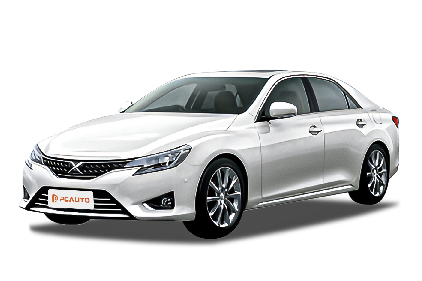Q
Is Mark X better than Crown?
It's difficult to simply decide which one is better, the Mark X or the Crown, as both have their own advantages. The Toyota Mark X 250 runs on gasoline, performing well in power delivery and directly offering drivers driving pleasure. In addition, its handling performance is outstanding, and the exterior design is more dynamic, catering to consumers who pursue vitality and dynamism. The Crown has always been renowned for its comfort and luxury. Its cabin features a reasonable layout, exceptionally comfortable seats, and an interior design that emphasizes premium quality. Significant efforts have been made in noise insulation to provide passengers with a quiet and comfortable ride. Furthermore, the Crown has consistently maintained a more upscale brand positioning. If you prioritize handling performance and dynamic design, the Mark X may suit you better; if you focus on luxurious comfort and premium brand image, the Crown would be the superior choice.
Special Disclaimer: This content is published by users and does not represent the views or position of PCauto.
Related Q&A
Q
How much horsepower does a 2005 Toyota Mark X have?
Back in 2005, the Toyota Mark X entered the Malaysian market with two engine options that drew attention from car enthusiasts: the 2.5 - liter 4GR - FSE V6 and the 3.0 - liter 3GR - FSE V6. Where the 2.5L produces around 215 hp, the 3.0L delivers roughly 256 hp – both packing Toyota's advanced direct - injection tech that delivered solid performance with decent fuel economy.
What made the Mark X stand out, though, was that it was a proper rear - wheel - drive sedan from Toyota – a classic, if you will. Car enthusiasts loved it for its smooth driving feel and stable handling, which were well - suited to Malaysia's road conditions and driving demands here.
Styling - wise, it struck a nice balance between sporty and comfortable. Inside, the build quality felt solid, and it came loaded with features: think multi - function steering wheel, a decent sound system – all the little things that make driving more enjoyable.
If you're into this kind of car, it is advisable for you to track one down for a test drive. You should experience that power and how it handles firsthand. And hey, keep an eye on Malaysia’s used car market too – a well - maintained Mark X can be a cost - effective purchase these days.
Q
What is the price of Mark X 2005?
The 2005 Toyota Mark X typically fetches between RM30,000 to RM50,000 on Malaysia's used car market. Of course, the actual price hinges on condition, mileage, modifications, and location. What makes this a standout? That classic FR (front-engine, rear-wheel drive) setup paired with either a 2.5L or 3.0L naturally aspirated V6 engine. Power delivery is smooth, maintenance costs are reasonable, and it's a certified favorite among local car enthusiasts – a true Japanese classic.
Now, considering its age, there are key things to watch for when buying. Give extra attention to the chassis rubber components, check the transmission's condition thoroughly, and make sure there's no history of flood damage. On the plus side, parts for the Mark X are pretty readily available in Malaysia, though some genuine OEM bits might require ordering through specific channels.
If your budget's tight but you still want driver engagement, the same-era Toyota Crown or Nissan Teana are worth a look. However, the Mark X holds its ground with superior modification potential and a sportier aesthetic. For peace of mind, source it through reputable used car platforms or professional dealers, and always insist on a comprehensive inspection report to keep the transaction transparent.
Q
Is the 2005 Toyota Mark X reliable?
In the Malaysian market, the 2005 Toyota Mark X has built a solid reputation for reliability. Under the hood, you'll find either a 2.5-liter or 3.0-liter V6 engine – smooth operators that deliver power in a refined, durable manner. Maintenance costs are pretty reasonable, and spare parts are generally easy to come by, making it a practical choice for local folks looking for a long-term daily driver.
What really sets this car apart is its rear-wheel-drive setup, which translates to a genuinely engaging driving experience. The interior feels well-put-together, with that typical Toyota solidity. Sure, it's not the newest kid on the block, but with proper care, these Mark Xs still hold up and offer a consistently dependable ride.
Now, considering its age, there are a few things to watch out for if you're in the market. When checking one out, pay close attention to the condition of the chassis rubber components, the suspension system, and obviously, the engine. Age-related wear and tear on these parts can definitely put a damper on your daily commute if not addressed.
For Malaysian buyers watching their wallets but still craving that V6, rear-wheel-drive sedan experience, the 2005 Mark X represents some serious bang for your buck. Toyota's strong local presence means there's no shortage of mechanics familiar with these cars, making after-sales service that much smoother. Prices on the used market are pretty approachable too, though – and this is crucial – the actual condition of individual cars can vary wildly. Do yourself a favor and insist on a professional inspection before handing over any cash.
Q
Does Mark X consume lots of fuel?
The fuel consumption of the Mark X cannot be generalized, as it is influenced by various factors. Regarding the vehicle's condition, proper engine maintenance—such as timely spark plug replacement and keeping the intake system clean—typically results in normal fuel efficiency. Conversely, issues like carbon buildup in the engine or underinflated tires may increase consumption.
Driving habits also significantly impact fuel usage. Smooth acceleration, avoiding sudden braking, and maintaining steady speeds help reduce consumption, while aggressive throttle input or high-speed driving will increase the consumption. Road condition is also an important factor, frequent stop-and-go traffic inevitably increases the fuel consumption compared to highway or smooth-road driving.
Therefore, the Mark X may don't consume lots of fuel. With proper maintenance, good driving habits, and appropriate route selection, its fuel consumption can be effectively managed.
Q
What's the transmission fluid capacity of the Toyota Mark X
Sorry, there is no exact information regarding the specific transmission fluid capacity of the Toyota Mark X. The required amount can vary depending on factors such as the vehicle model, transmission type, and design. Generally speaking, there are two common methods for changing transmission fluid: the gravity drain method, which typically requires less fluid, and the exchange machine method, which enables a more thorough fluid replacement but uses more fluid.
For accurate transmission fluid capacity details, I recommend consulting your vehicle's owner's manual, which should contain comprehensive specifications. Alternatively, you could contact an official Toyota dealership - their technicians can provide precise data based on your specific vehicle configuration.
Please note that regular transmission fluid changes are crucial for maintaining optimal transmission performance and longevity. Always follow the manufacturer's recommended service intervals and use the specified fluid grade.
Q
What type of oil does the Toyota Mark X use?
It's recommended to use Toyota Genuine Oil for Toyota Mark X, with specifications including 0W-20, 5W-20, and 5W-30. The 0W-20 is a full synthetic oil that offers excellent low-temperature fluidity, ensuring smoother cold start in frigid climates while improving fuel efficiency. The 5W-20, is also a good choice as the full synthetic oil, providing reliable low-temperature performance and engine protection suitable for most driving conditions. Meanwhile, the 5W-30 is a semi-synthetic oil that performs well across broader climate ranges, delivering stable lubrication and protection under high temperatures.
When selecting engine oil, consider your driving environment and usage purpose. For colder regions, 0W-20 is ideal, while 5W-20 or 5W-30 may be preferable in moderate climates or for high-mileage vehicles. Additionally, high-quality third-party oils that meet the engine's requirements can also serve as viable alternatives.
Q
How many airbags is Mark X equipped with?
Sorry, there is no specific information about the number of airbags equipped by the Mark X. Airbags are one of the important safety features in vehicles,which can pop out quickly during a collision, providing cushioning protection for occupants and reducing the risk of injury. The number of airbags varies across models of different years, versions, and trim levels. Generally, common automotive airbags include front airbags for the driver and front passenger, side airbags to mitigate injury during side impacts, and some models feature curtain airbags to protect front and rear occupants' heads. For precise information about the number of the Mark X's airbag, please refer to the vehicle's owner's manual or consult a Toyota dealer.
Q
Is Mark X equipped with V6 engine?
The Mark X is equipped with V6 engine. Some versions of the Toyota Mark X are equipped with V6 engine, such as those featuring the 5GR-FE, 3GR-FE, and 4GR-FSE engine codes. The V6 engine delivers robust power, enhancing the driving experience. Its structural design ensures smoother operation compared to some four-cylinder engines, showing more smooth power delivery. Additionally, V6 engine offers strong performance reserves, making it well-suited for both city driving and highway overtaking.
Different V6 engines vary in power and torque specifications, so it's recommended that buyers should choose the Mark X model that meets their performance needs and preferences.
Q
Is Mark X equipped with the turbocharger?
The fuel type of the 2005 Toyota Mark X 250 is gasoline, without clear mention of the equipment of turbocharger. Generally, Mark X models are equipped with naturally aspirated engines to deliver smooth power output and enjoyable driving experience. However, as the automotive market evolves, variations exist across different model years and versions. Certain special editions or later upgraded models may employ turbocharging technology to enhance performance such as power and torque, catering to diverse consumer demands. To confirm whether a specific Mark X model is equipped with turbocharger, it's advisable to check the vehicle's detailed technical specifications or consult a Toyota dealership.
Q
What's the fuel tank capacity of the Mark X?
There is no exact data about the fuel tank capacity of the Mark X. The fuel tank capacity may vary across different model years and versions. Generally, a vehicle's fuel tank capacity is clearly specified in the owner's manual or technical specifications. You may consult the owner's manual for your specific model to obtain precise figures. Understanding fuel tank capacity is crucial as it directly impacts the vehicle's driving range, enabling owners to better plan journeys and schedule refueling. Furthermore, factors such as driving habits and vehicle load conditions can also influence the actual distance achievable on a full tank.
Popular Cars
Model Year
Car Compare
Car Photo
Latest Q&A
Q
Does the 2019 Golf GTI have a timing belt or chain?
The 2019 Golf GTI uses a timing chain instead of a timing belt—a design that offers better durability and lower maintenance costs. Typically, a chain lasts as long as the engine itself and rarely needs replacement, whereas a belt requires inspection or replacement every 60,000 to 100,000 km. If neglected, a worn belt can snap and cause severe engine damage.
VW’s EA888 engine family has long relied on chain-driven systems, which are relatively quiet and highly reliable. That said, it’s crucial to periodically check the tensioner’s condition. Some earlier models experienced timing issues due to tensioner design flaws, but this was addressed in the 2019 version.
For performance enthusiasts, a chain system handles high-revving stress better, making it a common choice for hot hatches like the GTI. For daily driving, just stick to VW 50400/50700-spec oil as recommended in the manual—proper lubrication keeps the chain system healthy long-term.
One heads-up: If you hear noticeable metallic rattling near the front of the engine, have the guides or tensioner inspected ASAP. Unlike the telltale belt squeal before failure, this noise is a classic sign of chain-related wear.
Q
What is the recall on the 2019 GTI?
The 2019 Volkswagen Golf GTI was subject to a safety recall addressing two potential issues. First, the fuel pump control unit software could malfunction, potentially causing engine stalling in rare cases. Second, some vehicles might have rear suspension stabilizer link bolts that weren't tightened to specification, posing a loosening risk. Owners can visit authorized dealers for free software updates or bolt retightening.
These proactive recalls demonstrate Volkswagen's commitment to safety. Dealers often handle outstanding recall items during routine maintenance.
For performance-oriented models like the GTI, it's wise to go beyond recall checks. Pay close attention to the turbo system, DSG transmission fluid, and brake wear—these components endure more stress during spirited driving. If warning lights appear or you notice unusual noises, get a professional inspection promptly. Keeping the car in top shape ensures you can fully enjoy its dynamic capabilities.
Q
Does the 2019 GTI require premium gas?
The 2019 GTI does recommend using high-octane fuel (typically RON 95 or above). Its 2.0L turbocharged engine has a relatively high compression ratio, and premium gas ensures optimal performance while reducing knock risk. It also helps maintain engine cleanliness and long-term reliability.
While the car may tolerate lower-octane fuel (like RON 92), you’d see slightly reduced power output and fuel efficiency. Over time, it could also affect engine longevity. Turbocharged engines are particularly sensitive to octane ratings since turbos generate higher heat and pressure—high-octane fuel handles these conditions better.
Mixing different fuel grades occasionally won’t hurt, but sticking to the manufacturer’s recommendation is ideal. Also, periodic fuel additive treatments can help clean carbon buildup, especially for direct-injection engines.
One more thing: even with the same octane rating, fuel additive packages vary by brand. So, picking a reputable gas station matters too.
Q
How long will a 2019 GTI last?
The lifespan of a 2019 GTI largely depends on maintenance and driving habits. With regular oil changes, transmission fluid replacements, and avoiding aggressive driving, it can easily clock over 200,000 kilometers—or even more. Its 2.0T engine and DSG gearbox are proven combos, and as long as you stick to the factory service schedule, mechanical reliability won’t be an issue.
Just keep in mind: turbocharged engines demand extra care. Always use the right spec full-synthetic oil and monitor the cooling system. Climate plays a role too—hot, humid conditions mean paying extra attention to rubber seals and electronics. Every 50,000 km, have the timing chain and high-pressure fuel pump inspected (key items for turbos).
Driving style matters. Don’t redline it constantly, and let the engine warm up properly after cold starts. Rustproofing helps long-term durability, so regular underbody washes are smart. Nail these details, and this car’s built to last.
Q
How fast is the 2019 GTI?
The 2019 GTI truly delivers when it comes to performance. Under the hood lies a punchy 2.0-liter turbocharged four-cylinder, churning out 228 horsepower and 350 Nm of torque. Whether you opt for the engaging 6-speed manual or the lightning-fast 7-speed DSG, this hot hatch rockets from 0-100 km/h in just 6.3 seconds, with an electronically limited top speed of 250 km/h.
What really sets the GTI apart is its razor-sharp handling. The sport-tuned suspension and electronic differential lock work together to deliver precise steering and rock-solid cornering stability. It’s the perfect blend of everyday practicality and proper driver’s car thrills—a well-rounded hot hatch in every sense.
For enthusiasts, the GTI’s tuning potential is massive. Many owners go for ECU remaps or intake/exhaust upgrades to squeeze out even more power. Just remember to keep things street-legal—safety and compliance should always come first. Around here, these pocket rockets have a solid following, and it’s easy to see why.
View MoreRelated News

Rare big move, Toyota releases three sports cars: GR GT, GR GT3, Lexus LFA Concept
JamesDec 5, 2025

Rare move, Toyota will release three important models in one go on December 5th
AshleyDec 4, 2025

Will the Toyota Sienna be sold in Malaysia in the future?
JamesDec 4, 2025

Toyota Raize: When will this smart and compact SUV be available in Malaysia?
AshleyDec 2, 2025

Why is the Toyota Sienna so popular with so many people?
RobertDec 1, 2025
View More

















Pros
Cons